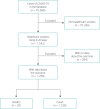Factors associated with the death of healthcare workers due to COVID-19 in the state of Amapá, Brazil
- PMID: 36118072
- PMCID: PMC9444215
- DOI: 10.47626/1679-4435-2022-911
Factors associated with the death of healthcare workers due to COVID-19 in the state of Amapá, Brazil
Abstract
Introduction: Frontline healthcare workers providing care for COVID-19 are more likely to get infected and die compared with other professionals. Deaths or sick leaves due to COVID-19 can affect the smooth operation of health services in areas with shortage of workers.
Objectives: To analyze factors associated with the death of healthcare workers due to COVID-19 in the state of Amapá, Brazil.
Methods: Analytical cross-sectional study using COVID-19 data from Amapá between March 2020 and January 2021. The association of independent variables (sex, race/color, age group, region of residence, comorbidity) with death was analyzed by logistic regression.
Results: Data from 1,258 workers were analyzed. The majority were women (67.7%; 852/1,258), multiracial (66.9%; 759/1,135), aged between 18 and 64 (98.3%; 1,226/1,247), with no comorbidity (86.6%; 1,090/1,258), from the Macapá metropolitan area (56.7%; 713/1,258). The mortality rate was 1.59%. Factors associated with death were: age group = 65 years (odds ratio = 10.43; 95% confidence interval [CI] = 2.78-39.11), comorbidity (odds ratio = 4.52; 95%CI = 1.74-11.74), and residence in the Macapá metropolitan area (odds ratio = 4.37; 95%CI = 1.25-15.29).
Conclusions: The recognition of factors that may have caused the death of healthcare workers in Amapá can support the recommendation of protective measures for the most susceptible, such as switching to activities with lower exposure to the virus or teleworking.
Keywords: coronavirus infections; epidemiology; healthcare workers; occupational health; regression analysis.
Conflict of interest statement
Conflicts of interest: None
Figures
Similar articles
-
Healthcare workers' stress when caring for COVID-19 patients: An altruistic perspective.Nurs Ethics. 2020 Nov;27(7):1490-1500. doi: 10.1177/0969733020934146. Epub 2020 Jul 14. Nurs Ethics. 2020. PMID: 32662326
-
Health Disparities of Coronavirus Disease 2019 in Texas, March-July 2020.South Med J. 2021 Oct;114(10):649-656. doi: 10.14423/SMJ.0000000000001308. South Med J. 2021. PMID: 34599344 Free PMC article.
-
Assessment of knowledge, attitude and practice toward COVID-19 and associated factors among health care workers in Silte Zone, Southern Ethiopia.PLoS One. 2021 Oct 5;16(10):e0257058. doi: 10.1371/journal.pone.0257058. eCollection 2021. PLoS One. 2021. PMID: 34610037 Free PMC article.
-
Epidemiological profile, occupational accidents, and socioeconomic characteristics of workers in the state of Amapá, Brazil: a time series analysis (2007-2017).Rev Bras Med Trab. 2021 Aug 4;19(2):181-190. doi: 10.47626/1679-4435-2020-583. eCollection 2021 Apr-Jun. Rev Bras Med Trab. 2021. PMID: 34603414 Free PMC article.
-
A rapid systematic review of the efficacy of face masks and respirators against coronaviruses and other respiratory transmissible viruses for the community, healthcare workers and sick patients.Int J Nurs Stud. 2020 Aug;108:103629. doi: 10.1016/j.ijnurstu.2020.103629. Epub 2020 Apr 30. Int J Nurs Stud. 2020. PMID: 32512240 Free PMC article.
References
-
- Teixeira CFS, Soares CM, Souza EA, Lisboa ES, Pinto ICM, Andrade LR, et al. A saúde dos profissionais de saúde no enfrentamento da pandemia de Covid-19. Cienc Saude Colet. 2020;25(9):3465–74. - PubMed
LinkOut - more resources
Full Text Sources

